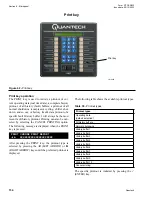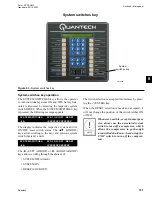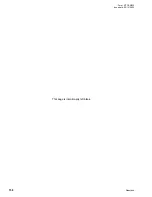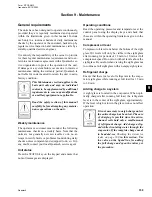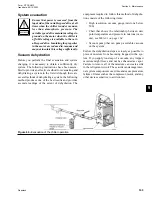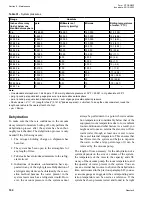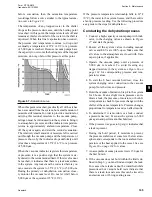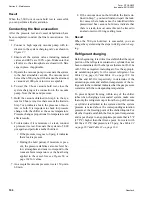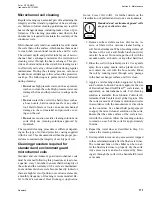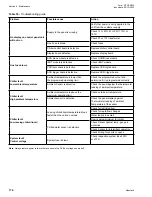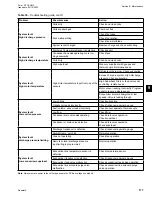
Quantech
166
Section 9 - Maintenance
Form QTC4-NM2
Issue date: 05/12/2023
Result
When the 5,000 μm vacuum hold test is successful,
you can perform a final evacuation.
Conducting the final evacuation
After the pressure test and vessel dehydration have
been completed, conduct the final evacuation as fol-
lows:
1. Connect a high capacity vacuum pump with in-
dicator, to the system charging valve as shown in
Figure 27
.
2. Ensure all the system valves including manual
valves and EEVs are 100% open. Make sure that
all valves to the atmosphere are closed with flare
caps in place, if applicable.
3. Operate the vacuum pump to evacuate the system
to the best attainable vacuum. The vacuum must
be less than 500 μm, but if that cannot be attained,
a vacuum at 1000 μm or lower is acceptable.
4. To start the 8 hour vacuum hold test, close the
system charging valve connection to the vacuum
pump. Note the time and pressure.
5. Hold the vacuum obtained in Step 4 in the sys-
tem for 8 hours. Any rise that exceeds the limits in
Step 7 can indicate a leak, the presence of mois-
ture, or both. It is important to check for pressure
change with the chiller at the same temperature.
Pressure changes proportional to temperature and
affects results.
6. To determine if it is moisture or a leak, conduct
a pressure rise test. Evacuate the system to 5,000
μm again and perform another hold test.
• If the pressure rise goes to 0 psig, it indicates
that a leak is present.
• During the hold period, if moisture is pres-
ent, the pressure stabilizes at some level be-
low atmosphere and must correspond to the
room ambient temperature or the heat being
applied to the vessel. See see
7.
An acceptable vacuum pressure rise is 150 μm in
60 min.
8. If the vacuum does not hold within the limits de-
fined in Step 7, you must find and repair the leak.
For cases where leaks cannot be identified while
pressurized but vacuum hold tests indicate that
there is a leak, in most cases this can be traced to
an elastomeric or O-ring sealing issue.
Result
When the 500 μm hold test is successful, you can
charge the system using the steps in
Refrigerant charg-
ing.
Refrigerant charging
Before beginning, it is critical to establish that the vapor
portion of the refrigerant container or cylinder has not
been contaminated with other gases that are not R-134a
or R-513A as required, including air. Use the appropri-
ate saturation property for the correct refrigerant. See
R-134a and R-513A respectively, to determine if the
saturation pressure and ambient temperature of the re-
frigerant in the container indicates that the gas pressure
coincides with the corresponding temperature.
To prevent liquid freezing within any of the chiller
tubes when charging an evacuated system, make sure
that only the refrigerant vapor from the top of the drum
or cylinder is admitted to the system until the system
pressure is raised above the corresponding saturation
pressure at the freezing point of the chilled liquids. For
all other liquids, establish the freeze point temperature
and vapor charge to an appropriate pressure that is 5°F
(2.78°C) higher than that freeze point. For water with
R-134a at 32°F, that pressure is 28 psig. See
.
Содержание QTC40160
Страница 22: ...Quantech 22 Form QTC4 NM2 Issue date 05 12 2023 This page is intentionally left blank...
Страница 94: ...Quantech 94 Form QTC4 NM2 Issue date 05 12 2023 This page is intentionally left blank...
Страница 100: ...Quantech 100 Form QTC4 NM2 Issue date 05 12 2023 This page is intentionally left blank...
Страница 158: ...Quantech 158 Form QTC4 NM2 Issue date 05 12 2023 This page is intentionally left blank...
Страница 187: ...Quantech 187 Form QTC4 NM2 Issue date 05 12 2023 This page is intentionally left blank...



